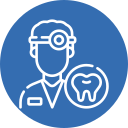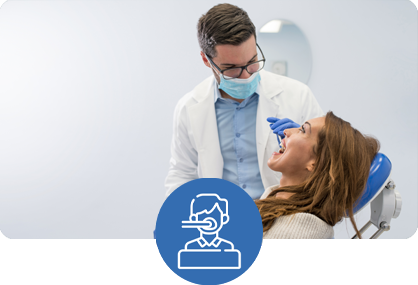What You’ll Learn About Sedation Dentistry
- Different types of sedation options from mild to deep
- Benefits of sedation dentistry for anxiety management
- What to expect before, during, and after sedation
- Special considerations for patients with unique needs
- How to determine which sedation option is right for you
Understanding Dental Anxiety and Its Impact
Dental anxiety affects millions of Americans, with studies showing that between 9-30% of the population avoids necessary dental care due to fear and anxiety. This avoidance can lead to serious oral health complications that could have been prevented with regular dental visits. The psychological impact extends beyond the dental office, often affecting overall quality of life and creating persistent stress around routine oral healthcare.
Many patients experience symptoms ranging from mild uneasiness to severe panic attacks at the thought of sitting in a dental chair. This anxiety can stem from various sources, including previous traumatic dental experiences, fear of pain or needles, concerns about loss of control, embarrassment about oral health condition, or sensory triggers like the sound of drills or the smell of dental materials. Physical manifestations often include elevated heart rate, sweating, trembling, difficulty breathing, and even nausea when contemplating dental appointments.
Left untreated, dental anxiety can create a vicious cycle where patients avoid routine care, leading to more serious dental problems that eventually require more invasive treatments, which in turn reinforces the initial anxiety. Combating dental anxiety is essential for maintaining good oral health and overall wellbeing. Research shows that patients with dental phobia are more likely to have missing teeth, untreated decay, and periodontal disease, demonstrating the significant health consequences of avoiding professional dental care.
Fortunately, modern dentistry offers several sedation options specifically designed to help anxious patients receive the dental care they need comfortably and without fear. These approaches have transformed the dental experience for countless individuals who previously avoided treatment, allowing them to maintain optimal oral health without psychological distress. Dental professionals now recognize anxiety management as a crucial component of comprehensive patient care.
What is Sedation Dentistry?
Sedation dentistry, sometimes called sleep dentistry, includes various techniques used to help patients relax during dental procedures. Despite the nickname “sleep dentistry,” most sedation methods don’t actually put patients to sleep (except for general anesthesia). Instead, they work to calm anxiety while allowing patients to remain conscious and responsive. These techniques have made dental care accessible for millions of people who used to avoid treatment due to fear.
At Oakwood Dental Clinics’ seven convenient locations, sedation dentistry services are designed to alleviate anxiety and fear associated with dental procedures, provide comfort during longer or more complex treatments, enable completion of multiple procedures in a single visit, help patients with strong gag reflexes or sensitive teeth, and make dental care accessible for those with special needs. The practice employs board-certified professionals specifically trained in various sedation techniques, ensuring the highest standard of care and patient safety throughout every procedure.
Sedation dentistry represents a significant advancement in patient-centered care, allowing dentists to provide necessary treatments while prioritizing patient comfort and emotional wellbeing. The range of available options means that sedation can be tailored to each individual’s specific needs, anxiety level, and the complexity of their dental treatment. This personalized approach has transformed the dental experience for countless patients who previously avoided essential care due to fear and anxiety, ultimately improving both oral health outcomes and quality of life.
Types of Dental Sedation Options
Dental sedation exists on a spectrum from minimal to deep, with different options suitable for varying levels of anxiety and procedure complexity. Here’s a comprehensive overview of the sedation options available, each carefully designed to address specific patient needs while ensuring safety and effectiveness during dental treatment:
Nitrous Oxide (Laughing Gas)
Nitrous oxide, commonly known as “laughing gas,” is a mild sedative administered through a small mask placed over the nose. This fast-acting inhaled sedation provides several benefits: It creates a pleasant, tingling sensation throughout the body while inducing a state of relaxation that helps patients remain calm during treatment. The gas is mixed with oxygen and carefully monitored to ensure optimal effects and safety throughout the procedure.
It takes effect within minutes, creates feelings of relaxation and mild euphoria, and patients remain fully conscious and can respond to instructions. The effects wear off quickly once the gas is turned off, allowing patients to typically drive themselves home after treatment. It’s safe for most patients, including children. Unlike other sedation methods, nitrous oxide doesn’t require pre-appointment preparation or post-procedure recovery time, making it an exceptionally convenient option for patients with busy schedules.
Nitrous oxide is ideal for patients with mild to moderate anxiety or those undergoing shorter procedures. It’s often the first option recommended for patients new to sedation dentistry. Dental professionals appreciate nitrous oxide for its predictable effects, excellent safety profile, and the ability to adjust sedation levels in real-time during treatment to ensure optimal patient comfort.
Oral Sedation
Oral sedation involves taking prescribed anti-anxiety medication in pill form before your dental appointment. Depending on the dosage, oral sedation can range from minimal to moderate: The medication is typically taken approximately one hour before the scheduled appointment to allow sufficient time for the sedative effects to develop. This approach offers a deeper level of relaxation than nitrous oxide while still maintaining consciousness.
It typically uses benzodiazepines like diazepam or triazolam, creates a deeper state of relaxation than nitrous oxide, and patients remain conscious but may feel drowsy. Some patients may have limited memory of the procedure. The effects last longer, requiring someone to drive you home, and may be taken the night before for patients with severe anxiety. The amnesic properties of these medications can be particularly beneficial for highly anxious patients, as they often have little recollection of the dental procedure afterward, helping to prevent the reinforcement of dental fears.
This option works well for patients with moderate anxiety or those undergoing longer procedures. The dentist will determine the appropriate dosage based on your anxiety level, body weight, and the length of the procedure. Oral sedation offers a good balance between effectiveness and minimal invasiveness, making it a popular choice for many patients seeking anxiety relief during dental treatment without the need for intravenous administration.
IV Sedation
Intravenous (IV) sedation delivers anti-anxiety medication directly into the bloodstream for a more profound sedative effect: This approach allows for precise control of sedation levels throughout the procedure, as the dentist can adjust medication dosage in response to patient needs and treatment requirements. IV sedation creates a state often described as “twilight sleep” where patients remain technically conscious but deeply relaxed.
It produces moderate to deep sedation, with medication administered through a small needle in the arm. This allows the dentist to adjust sedation levels throughout the procedure. Patients remain technically conscious but may drift in and out of sleep and have little to no memory of the procedure. IV sedation requires pre-procedure fasting and post-procedure monitoring, and someone must accompany you to drive you home. The medications used typically include benzodiazepines, sometimes combined with other sedatives for optimal effect.
IV sedation is particularly beneficial for patients with severe anxiety, those undergoing extensive dental work, or individuals with strong gag reflexes. Our comprehensive sleep dentistry solutions include IV sedation administered by specially trained professionals. This approach is also ideal for complex procedures that require extended time in the dental chair, as it allows patients to remain comfortable throughout lengthy treatments that might otherwise cause significant physical and emotional distress.
General Anesthesia
General anesthesia represents the deepest form of sedation, rendering patients completely unconscious: This comprehensive approach to sedation is typically reserved for the most complex dental procedures or for patients whose medical or psychological conditions make other sedation methods unsuitable. Under general anesthesia, patients are completely unaware of their surroundings and experience no pain or anxiety during treatment.
It’s administered by an anesthesiologist or specially trained dental anesthesiologist. Patients are completely unaware and unable to respond during treatment. General anesthesia requires extensive monitoring of vital signs throughout the procedure and is used for complex surgical procedures or patients with special needs. It requires thorough pre-operative evaluation and post-operative recovery. The medications used affect the entire body and brain, temporarily suspending consciousness until the procedure is complete.
This option is typically reserved for oral surgery, extensive reconstructive procedures, or patients with certain medical or behavioral conditions that make other sedation methods unsuitable. While it carries slightly higher risks than lighter forms of sedation, when administered by qualified professionals with proper monitoring, general anesthesia provides a safe option for patients who would otherwise be unable to receive necessary dental treatment due to extreme anxiety, physical limitations, or complex medical needs.
Determining the Right Sedation Option for You
Choosing the appropriate sedation method depends on several factors that will be carefully evaluated during your consultation. This personalized assessment ensures that the sedation approach selected will provide optimal comfort while maintaining safety throughout your dental treatment. The comprehensive evaluation considers multiple aspects of your health, anxiety level, and treatment needs:
Anxiety Level Assessment
The assessment begins by evaluating your specific level of dental anxiety. Mild anxiety may respond well to nitrous oxide, moderate anxiety often benefits from oral sedation, and severe anxiety or phobia might require IV sedation or general anesthesia. Dentists use specialized assessment tools and questionnaires to objectively measure anxiety levels, helping to determine the most appropriate intervention. They’ll discuss specific triggers for your dental anxiety, whether they’re related to particular procedures, sensory experiences, or past negative experiences, allowing for a truly customized approach to your comfort needs.
Medical History Evaluation
Your complete medical history is crucial in determining sedation safety. This includes considering certain medical conditions that may limit sedation options, current medications that might interact with sedatives, previous experiences with sedation or anesthesia, and allergies to medications. Factors like respiratory conditions, cardiovascular health, liver or kidney function, and neurological disorders all influence sedation decisions. The dental team will often consult with your primary care physician when necessary to ensure all medical considerations are properly addressed before proceeding with sedation.
Procedure Complexity
The nature of your dental treatment influences sedation recommendations. Simple procedures like cleanings might need minimal sedation, multiple fillings or root canals may warrant moderate sedation, and extensive surgical procedures often require deeper sedation. The anticipated duration of treatment is particularly important, as longer procedures typically benefit from deeper sedation methods that provide sustained comfort. Additionally, the invasiveness of the procedure and potential for discomfort are carefully weighed when determining the optimal sedation approach for your specific treatment plan.
Personal Preferences
Your input in the decision-making process is valued. This includes your comfort level with different sedation methods, concerns about awareness during treatment, preferences regarding recovery time, and budget considerations (as insurance coverage varies). Some patients prefer to remain more alert during procedures, while others would rather have minimal awareness or memory of the treatment. The dental team respects these preferences while balancing them with clinical considerations to arrive at the most appropriate sedation recommendation for your individual situation.
At Oakwood Dental Clinics, the experienced team will guide you through these considerations during a comprehensive consultation, ensuring you receive the most appropriate sedation option for your unique situation. This collaborative approach to sedation planning ensures that your dental experience will be as comfortable and stress-free as possible while delivering the care you need for optimal oral health.
Special Considerations for Unique Patient Needs
Sedation Dentistry for Children
Children with dental anxiety or those requiring extensive treatment can benefit from sedation dentistry, but with important modifications. Dosages are carefully calculated based on age and weight, with nitrous oxide often being the first choice for pediatric patients. Oral sedation may be used for more anxious children, while general anesthesia is reserved for extensive procedures or special behavioral needs. Parents are thoroughly educated about pre- and post-sedation care. Pediatric sedation protocols include additional safety measures and monitoring techniques specifically designed for younger patients whose physiological responses may differ from adults.
This gentle approach to pediatric sedation ensures children receive necessary dental care while developing positive associations with dental visits. Child psychology is carefully considered in the sedation approach, with age-appropriate communication and preparation techniques employed to reduce fear and build trust. The goal extends beyond the immediate treatment to fostering a lifetime of comfortable dental experiences, preventing the development of dental phobias that could persist into adulthood and compromise long-term oral health.
Sedation for Patients with Special Needs
Patients with physical, cognitive, or developmental disabilities often face unique challenges in receiving dental care. Dental sedation for special needs patients addresses these challenges through customized sedation protocols based on individual needs, coordination with primary care physicians and specialists, accommodations for sensory sensitivities, modified communication techniques, specialized equipment and positioning, and comprehensive pre-appointment preparation. Each protocol is developed with consideration of the specific condition, including potential drug interactions with ongoing medications and physiological considerations unique to certain disabilities.
The team has extensive experience working with patients with autism spectrum disorders, Down syndrome, cerebral palsy, and other conditions that may make traditional dental visits challenging. This specialized approach often involves creating detailed personalized care plans that address not only the dental treatment needs but also environmental modifications, communication strategies, and comfort measures specific to each patient’s unique requirements. Family members and caregivers are integrated into the treatment planning process, providing valuable insights that help create the most supportive and effective care experience possible.
Sedation for Elderly Patients
Older adults may require special considerations when it comes to sedation dentistry. This includes careful medication selection to avoid interactions with existing prescriptions, lower dosages to account for changes in metabolism, monitoring for age-related conditions that might affect sedation safety, consideration of mobility issues in positioning and recovery, and management of conditions like dementia or Parkinson’s disease. Age-related changes in organ function, particularly liver and kidney function which process medications, necessitate modified approaches to medication selection and dosing protocols.
Geriatric dental sedation protocols ensure safe, comfortable care for seniors while addressing their unique oral health needs. The approach considers not only physical health factors but also cognitive status and psychological comfort. For patients with dementia or memory impairments, sedation can reduce the confusion and distress that might otherwise accompany dental procedures. The dental team works closely with geriatric medical providers when necessary to ensure comprehensive, coordinated care that maintains both oral health and overall wellbeing for elderly patients.
The Sedation Dentistry Process: What to Expect
Pre-Appointment Preparation
Proper preparation is essential for safe and effective sedation. This begins with an initial consultation to assess anxiety, medical history, and treatment needs. Pre-sedation instructions will include specific guidelines regarding fasting requirements (typically 6-8 hours for deeper sedation), medication adjustments, what to wear (loose, comfortable clothing), and arranging transportation home. You’ll also complete paperwork including consent forms and pre-operative questionnaires, and have the opportunity to address any remaining questions. This comprehensive preparation phase ensures both physical readiness for sedation and psychological comfort through thorough understanding of the upcoming procedure.
For oral or IV sedation, you may need to take medication the night before or morning of your appointment. The timing of these medications is precisely calculated to ensure optimal effects during your treatment window. Patients are provided with detailed written instructions regarding all aspects of preparation, including specific times for medication administration, fasting requirements, and what personal items to bring to the appointment. This thorough preparation contributes significantly to both the safety and effectiveness of the sedation experience.
During Your Appointment
On the day of your procedure with sedation, you’ll begin with arrival and final preparation where vital signs are checked and final questions answered. Then sedation will be administered depending on the method – nitrous oxide delivered via nasal mask, IV line placed for intravenous sedation, or confirmation that oral medication has taken effect. The dental team creates a calm, quiet environment to enhance the effectiveness of sedation and minimize any potential anxiety triggers during this initial phase of your appointment.
Throughout the procedure, you’ll be monitored continuously with tracking of blood pressure, heart rate, oxygen levels, respiration, and level of consciousness. The dental procedure will be completed while you remain comfortable and relaxed, followed by gradual sedation reversal/reduction for a return to full awareness. Advanced monitoring equipment provides real-time data on all vital functions, allowing for immediate adjustments to sedation levels if needed to maintain optimal comfort and safety throughout the entire treatment process.
The team maintains constant communication, ensuring your comfort throughout the procedure. Even under sedation, many patients can respond to simple instructions, allowing for a collaborative approach to care. For deeper sedation levels, the dental team uses visual cues and gentle techniques to proceed with treatment while maintaining patient comfort. The entire process is carefully choreographed to provide efficient, effective dental care while prioritizing patient wellbeing at every stage.
Post-Sedation Recovery
Recovery varies based on the type of sedation received. With nitrous oxide, effects dissipate within minutes, with normal activities resumable almost immediately. Oral sedation involves a gradual return to alertness over several hours. IV sedation/general anesthesia requires monitored recovery in a dedicated area before release to your caregiver. During this recovery period, vital signs continue to be monitored until they return to normal parameters, ensuring complete metabolization of sedative medications before discharge.
You’ll receive detailed aftercare instructions, including activity restrictions, dietary guidelines, pain management, when to resume regular medications, and follow-up appointment scheduling. For deeper sedation, a responsible adult must drive you home and stay with you for several hours. The dental team will also provide emergency contact information and clear guidance on what symptoms might warrant medical attention. A follow-up call the day after treatment is standard practice for patients who have received moderate to deep sedation, allowing the dental team to check on recovery progress and address any questions or concerns that may arise.
Benefits of Choosing Sedation Dentistry
Anxiety Reduction and Comfort
The most immediate benefit of sedation dentistry is the elimination or significant reduction of anxiety. It creates a relaxed, comfortable experience, reduces the psychological stress of dental visits, helps build positive associations with dental care, and enables treatment for patients who would otherwise avoid necessary care. This anxiety management extends beyond the immediate procedure, often helping patients break the cycle of dental fear that may have persisted for years or even decades, allowing them to establish regular preventive care routines that improve long-term oral health outcomes.
Efficiency and Convenience
Sedation allows for more efficient treatment delivery. Multiple procedures can be completed in a single visit, longer appointments are tolerable, reducing the number of visits needed, dentists can work more efficiently when patients are relaxed, and you’ll spend less time overall in the dental chair. This efficiency benefits both patients and practitioners, allowing for more comprehensive treatment planning and execution. For patients with busy schedules or those who must travel significant distances for dental care, the ability to consolidate multiple procedures into fewer appointments represents a substantial practical advantage of sedation dentistry.
Pain Management and Control
While local anesthetics handle physical pain, sedation addresses the emotional components. It reduces perception of time and treatment, diminishes memory of the procedure, helps manage strong gag reflexes, and minimizes discomfort from holding your mouth open for extended periods. The anxiety-reducing effects of sedation complement the pain-blocking properties of local anesthesia, creating a more comprehensive approach to patient comfort. Additionally, patients under sedation typically require less local anesthetic, reducing potential side effects while maintaining excellent pain control throughout dental procedures.
Improved Oral Health Outcomes
Perhaps most importantly, sedation dentistry leads to better long-term oral health. Regular preventive care becomes accessible to anxious patients, necessary treatments aren’t postponed due to fear, comprehensive care can be provided before conditions worsen, and patients develop healthier attitudes toward dental maintenance. Clinical studies have demonstrated that patients who utilize sedation dentistry services are more likely to maintain regular preventive care schedules and accept recommended treatments, resulting in fewer dental emergencies, less extensive restorative needs, and better overall oral health status compared to individuals whose dental anxiety remains unaddressed.
Safety Protocols and Considerations
Sedation Safety Standards
- Thorough pre-procedure patient evaluation
- Advanced monitoring equipment and protocols
- Specialized training for all staff involved in sedation
- Emergency preparedness and response planning
- Strict adherence to professional guidelines and regulations
At Oakwood Dental Clinics, patient safety is the highest priority when administering dental sedation. The comprehensive safety protocols include professional qualifications where the sedation dentistry team maintains advanced training and certification in sedation techniques, regular continuing education to stay current with best practices, certification in Advanced Cardiac Life Support (ACLS), and membership in professional organizations focused on dental sedation. These qualifications exceed standard requirements, reflecting the practice’s commitment to providing the safest possible sedation experience for every patient regardless of the sedation level required.
Before administering any sedation, there’s thorough pre-sedation screening including comprehensive medical history review, evaluation of current medications, assessment of airway and other physical factors, appropriate laboratory tests when indicated, and consultation with primary care physicians when necessary. This detailed screening process helps identify any potential risk factors that might influence sedation approach or require special monitoring protocols. The practice follows evidence-based guidelines established by professional dental organizations and regulatory bodies to ensure that all sedation procedures meet or exceed industry safety standards.
During sedation procedures, state-of-the-art vital signs monitoring equipment is utilized, including pulse oximetry for continuous oxygen level tracking, blood pressure monitoring at regular intervals, capnography for respiratory monitoring during deeper sedation, and emergency medications and equipment readily available. This comprehensive monitoring allows for immediate detection of any changes in patient status, enabling prompt intervention if needed. The monitoring protocols are tailored to the specific sedation method being used, with more intensive monitoring implemented for deeper sedation levels.
The offices maintain written emergency protocols, regular emergency drills and team training, crash cart with emergency medications and equipment, oxygen delivery systems, and Automated External Defibrillator (AED). Every team member has a designated role in emergency response, ensuring coordinated action in the unlikely event of a sedation-related complication. The practice conducts regular reviews of safety procedures and updates protocols based on evolving best practices in dental sedation to maintain the highest standards of patient care and safety.
Conclusion: Transforming Dental Experiences Through Sedation
Dental anxiety should never stand between you and optimal oral health. At Oakwood Dental Clinics, comprehensive sedation dentistry options provide solutions for patients of all ages and anxiety levels, from mild nervousness to severe dental phobia. The personalized approach to sedation selection ensures that each patient receives the most appropriate level of anxiety management for their specific situation, making necessary dental care accessible to everyone regardless of previous negative experiences or psychological barriers to treatment.
Through a patient-centered approach, thousands of anxious patients have received necessary dental care in comfort and without fear. The team’s specialized training, state-of-the-art facilities across seven convenient locations, and commitment to safety ensure that your sedation dentistry experience will be positive and effective. This transformation of the dental experience has profound implications not only for immediate comfort during procedures but also for long-term oral health maintenance and the development of healthier attitudes toward professional dental care.
Whether you need a simple cleaning, complex restorative work, or cosmetic procedures, sedation options can be tailored to your specific needs and comfort level. Don’t let dental fear compromise your smile or health. Contact Oakwood Dental Clinics today to learn more about sedation dentistry services and take the first step toward stress-free dental care. With the right sedation approach, you can overcome dental anxiety and establish a sustainable pattern of regular dental visits that will protect your oral health for years to come.

 718-979-2121
718-979-2121












